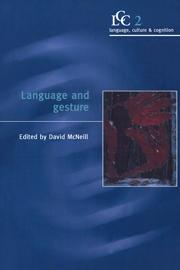Book contents
- Frontmatter
- Contents
- Acknowledgments
- Introduction
- Part 1 Gesture in action
- Part 2 Gesture in thought
- Part 3 Modeling gesture performance
- Part 4 From gesture to sign
- 16 Blended spaces and deixis in sign language discourse
- 17 Gestural precursors to linguistic constructs: how input shapes the form of language
- 18 Gesture to sign (language)
- Index
18 - Gesture to sign (language)
Published online by Cambridge University Press: 07 January 2010
- Frontmatter
- Contents
- Acknowledgments
- Introduction
- Part 1 Gesture in action
- Part 2 Gesture in thought
- Part 3 Modeling gesture performance
- Part 4 From gesture to sign
- 16 Blended spaces and deixis in sign language discourse
- 17 Gestural precursors to linguistic constructs: how input shapes the form of language
- 18 Gesture to sign (language)
- Index
Summary
Introduction
When gesture is defined as body movement that communicates more or less consciously, and Sign is taken as a generic term for natural sign languages, the progression from gesture to Sign is entirely natural. What makes it so is the nature of the hominid phenotype and its attributes – its vision and the physical structure and use of hands, arms, faces, and bodies. The nature of the physical universe is also involved, because an early cognitive advance was/is to see the world composed of things that persist and actions that disappear even as they appear. Animals gain information from what they see. Social animals learn to survive as they do by watching and aping movements of parents and elders. Higher animals make movements for specific purposes. Chimpanzees make a few gestures; e.g., movements reliably interpreted as asking for food or for grooming. Humans turn gesture into Sign when they perceive that a gesture made of a hand and its movement may depict things (animate and inanimate) and at the same time duplicate features of actions done by or to such things. Foveal vision discriminates among the many forms a hand can assume, and peripheral vision faithfully interprets the multiplicity of differences in limb movements. Thus a gesture may express both noun-like and verb-like meanings and at the same time show them related. Words and sentences appeared simultaneously when gesture became Sign. It is doubtful, however, that hand–arm gestures would have become Sign were it not that the gesture-maker was in full view, allowing face and body changes to add essential features to the expression of feeling–thought.
- Type
- Chapter
- Information
- Language and Gesture , pp. 388 - 399Publisher: Cambridge University PressPrint publication year: 2000
- 6
- Cited by

